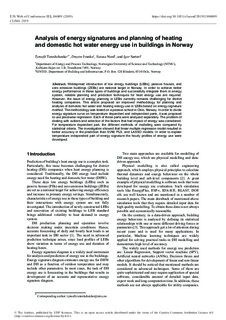| dc.contributor.author | Tereshchenko, Tymofii | |
| dc.contributor.author | Ivanko, Dmytro | |
| dc.contributor.author | Nord, Natasa | |
| dc.contributor.author | Sartori, Igor | |
| dc.date.accessioned | 2019-09-02T07:33:48Z | |
| dc.date.available | 2019-09-02T07:33:48Z | |
| dc.date.created | 2019-08-23T10:20:39Z | |
| dc.date.issued | 2019 | |
| dc.identifier.issn | 2267-1242 | |
| dc.identifier.uri | http://hdl.handle.net/11250/2611930 | |
| dc.description.abstract | Widespread introduction of low energy buildings (LEBs), passive houses, and zero emission buildings (ZEBs) are national target in Norway. In order to achieve better energy performance in these types of buildings and successfully integrate them in energy system, reliable planning and prediction techniques for heat energy use are required. However, the issue of energy planning in LEBs currently remains challenging for district heating companies. This article proposed an improved methodology for planning and analysis of domestic hot water and heating energy use in LEBs based on energy signature method. The methodology was tested on a passive school in Oslo, Norway. In order to divide energy signature curve on temperature dependent and independent parts, it was proposed to use piecewise regression. Each of these parts were analyzed separately. The problem of dealing with outliers and selection of the factors that had impact of energy was considered. For temperature dependent part, the different methods of modelling were compared by statistical criteria. The investigation showed that linear multiple regression model resulted in better accuracy in the prediction than SVM, PLS, and LASSO models. In order to explain temperature independent part of energy signature the hourly profiles of energy use were developed. | nb_NO |
| dc.description.sponsorship | The authors gratefully acknowledge the support from the Research Council of Norway through the research projects: the Research Centre on Zero Emission Neighbourhoods in Smart Cities (FME ZEN) and Energy for domestic hot water in the Norwegian low emission society under VarmtVann2030 within EnergiX program. | nb_NO |
| dc.language.iso | eng | nb_NO |
| dc.publisher | EDP Science | nb_NO |
| dc.relation.ispartof | CLIMA 2019 Congress | |
| dc.rights | CC BY 4.0 | * |
| dc.rights.uri | http://creativecommons.org/licenses/by-nc-nd/4.0/deed.no | * |
| dc.title | Analysis of energy signatures and planning of heating and domestic hot water energy use in buildings in Norway | nb_NO |
| dc.type | Conference object | nb_NO |
| dc.type | Journal article | nb_NO |
| dc.type | Peer reviewed | nb_NO |
| dc.description.version | publishedVersion | |
| dc.rights.holder | © 2019 The authors | nb_NO |
| dc.subject.nsi | VDP::Teknologi: 500 | nb_NO |
| dc.source.volume | 111 | nb_NO |
| dc.source.journal | E3S Web of Conferences | nb_NO |
| dc.identifier.doi | 10.1051/e3sconf/201911106009 | |
| dc.identifier.cristin | 1718194 | |
| dc.relation.project | Norges forskningsråd: 257660 | nb_NO |
| cristin.unitcode | 7401,30,20,0 | |
| cristin.unitname | Bygninger og installasjoner | |
| cristin.ispublished | true | |
| cristin.fulltext | original | |
| cristin.qualitycode | 1 | |

